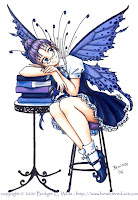"This country is not Fairy-land. What is it? 'Tis the land of Fancy, and is of that pleasant kind that, when you tire of it, -whisk!- you clap the leaves of this book together and 'tis gone, and you are ready for every-day life,
with no harm done.
with no harm done.
"And now I lift the curtain that hangs between here and No-man's-land. Will you come with me, sweet Reader? I thank you. Give me your hand."
So begins The Merry Adventures of Robin Hood, written by American author Howard Pyle in 1883.
 |
| Howard Pyle American Illustrator and Writer from Wilmington, Delaware March 5, 1853-November 9,1911 |
When he called me "sweet Reader," I was immediately hooked. In fact, I read these two paragraphs aloud to my husband, Jeff, because I was so excited to give my hand and enter the land of Fancy. And enter I did...
 |
| My husband, Jeff. The day he married this neurotic book reading fool. January 23, 2010 |
Pyle adapted the traditional Robin Hood stories and legends for children readers. Each chapter follows Robin Hood in his many adventures of recruiting his band of Merry Men, foiling the Sheriff of Nottingham time and again, and detailing their methods of "robbing from the rich and giving to the poor" in an effort to help fellow man.
 |
| The edition that I read. Sterling Publishing Co., Inc. New York |
 |
| Robin Hood and his Merry Men |
The only disappointment I experienced was the absence of Maid Marian in this version of the Robin Hood tale.
 |
| Robin Hood and Maid Marian |
Being written for an audience of children, Pyle has created a colorful narrative with his creation of an "old English" dialect that is both poetic and light-hearted. Considering for my passion for language, I was simply tickled by
this new "old" dialect!
this new "old" dialect!
In Part One, Chapter One, Robin encounters a Tinker "while walking merrily along the roadside where the grass was sweet with daisies."
Like any men encountering strangers on a leisurely stroll through the forest, Robin and the Tinker initiate their acquaintance with immediate challenges. After a few choice words have been exchanged, Robin laughingly tells the Tinker, "Why, thy wits are like beer, and do froth up most when they grow sour! But right art thou, man, for I love ale and beer right well."
And who doesn't love a frothy beer? (Well, truthfully, I don't really love beer. But most people do.) So now Robin officially recruits the Tinker as a member of his band of outlaws. The deal is sealed over a foaming beverage.
 |
| Can't you just smell how sweet the daisies are? |
 |
| He does not encounter Tinkerbell... but note how she does wear Lincoln green. |
 |
| But rather, he encounters a Tinker a.k.a. an itinerant tinsmith. |
Like any men encountering strangers on a leisurely stroll through the forest, Robin and the Tinker initiate their acquaintance with immediate challenges. After a few choice words have been exchanged, Robin laughingly tells the Tinker, "Why, thy wits are like beer, and do froth up most when they grow sour! But right art thou, man, for I love ale and beer right well."
 |
| Mmmmm...frothy beer. |
And who doesn't love a frothy beer? (Well, truthfully, I don't really love beer. But most people do.) So now Robin officially recruits the Tinker as a member of his band of outlaws. The deal is sealed over a foaming beverage.
 |
| The deal is sealed. |
One of the most charming activities I found in Robin Hood is the propensisty of these grown men of the forest to break into song at any moment
for the sake of entertainment.
Long gone are these days of self-entertainment, replaced by the mind-numbing atrocities of television, radio, and video games.
 |
| I'd much rather read. |
 |
| Sometimes I do listen to Classical music while reading. |
 |
| Um...I'd rather do anything else! |
During Robin Hood's days, circa 1100, even books were a rare form of entertainment, reserved for the educated and the wealthy. Books were a real luxury during that time, each copy being handwritten by paid scribes on vellum, which is made from calf skin, and bound with wood covered in leather.
 |
| A wood covered book circa 12th Century |
 |
| Handwritten text on parchment or vellum |
 |
| A Medieval scribe |
So the Merry Men of Sherwood Forest had to discover other means of entertainment during their frolicking ventures through the woods. Music filled this void. It was a common practice to engage in the singing of ballads while basking in the freshness of Nature's glories.
For example, in Part Three, Chapter Three, the brave Will Scarlet recalls a song "that a certain minstrel used to sing" in his father's hall. It begins,
"In the merry blossom time,
When love-longings flood the breast,
When the flower is on the lime,
When the small fowl builds her nest,
Sweetly sings the nightingale
And the throstle-cock so bold;
Cuckoo in the dewy dale,
And the turtle in the wild.
But the robin love dear,
For he singeth through the year.
Robin! Robin!
Merry Robin!
So I'd have my true love be:
Not to fly
At the nigh
Sign of cold adversity."
And there are so many other delightful ditties sprinkled generously throughout the pages of Robin Hood. The book is also filled with adventures and trials for grown-ups and children alike. The characters are amusing and daring, entertaining and brave, clever and witty. Well, the protagonists are...Pyle portrays some of the adversaries of Robin Hood and his Merry Men as dimwitted and dense, boorish and blundering, and sometimes just downright dumb. These characteristics do provide many opportunities for a great big belly laugh from the sweet Reader. All in all, I found Robin Hood to be a light, easy, and entertaining read. Simply satiating for this hungry reader.
However, after finishing Robin Hood, I became interested in the history of the Robin Hood legend. So I commenced some brief research on wikipedia.com. As it turns out, there are piles of history on the character of Robin Hood. I was surprised to find that the first clear reference to Robin Hood appeared in William Langland's Piers Plowman, a poem dating from the mid to late Fourteenth Century. The allegorical character Sloth personified by the lazy priest, confesses, "I kan [know] not parfitly [perfectly] my Paternoster as the preest it singeth,/ But I kan rymes of Robyn Hood." Robin Hood also appears in many traditional English ballads from
the Fifteenth through the Seventheenth Centuries.
 |
| A page from William Langland's Piers Plowman |
There is much speculation if a real Robin Hood as ever really existed. He as been referred to as the Earl of Huntington and portrayed as a contemporary of the late Twelfth Century king, Richard the Lionheart.
 |
| King Richard the Lionheart |
Robin Hood has shown up in Thirteenth Century French pastourelles (lyric forms concerning the romance of shepherdesses) as well as Sixteenth Century Germanic goblin legends. Some academics claim that the Robin Hood legend stems from actual historical outlaws such as Sir William Wallace, the Thirteenth Century Scottish knight so famously portrayed
by Mel Gibson in Braveheart.
 |
| Mel Gibson as William Wallace in the 1995 Academy Award winning film Braveheart |
Others claim Robin Hood may have been Hereward the Wake, an Eleventh Century exile who led local resistance against the Norman Conquest of England.
 |
| Hereward the Wake |
But I guess we can never know who this Robin Hood really was. What we do know is that he robbed from the rich and gave to the poor, he was an extraordinary swordsman and archer who donned Lincoln green clothes, and sought to assist his fellow man in need with his band of Merry Men.
We also know that Robin Hood is the outlaw who we cannot help but love. As a result, he continues to make appearances in contemporary literature, television and movies. To find him elsewhere, check out the wikipedia entries for
"Robin Hood in popular culture" and
"List of films and television series featuring Robin Hood."
Happy reading.
 |
| Robin Hood, the Archer. |
 |
| Archer James, the Baby. Coming this May. |
We also know that Robin Hood is the outlaw who we cannot help but love. As a result, he continues to make appearances in contemporary literature, television and movies. To find him elsewhere, check out the wikipedia entries for
"Robin Hood in popular culture" and
"List of films and television series featuring Robin Hood."
Happy reading.
























